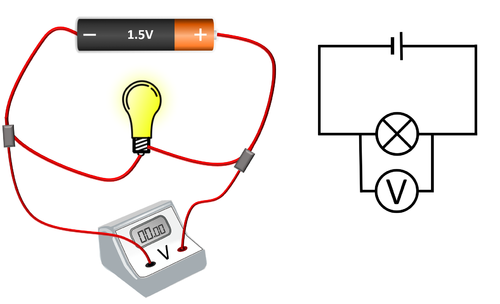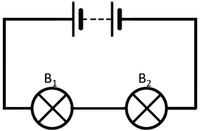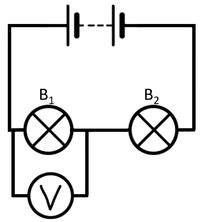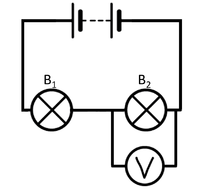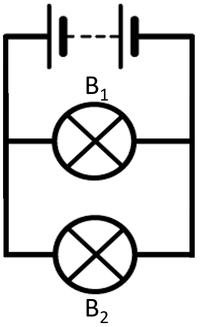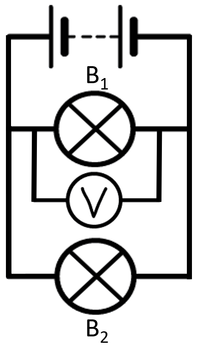Difference between revisions of "Voltmeter"
(→Key Stage 4) |
|||
| Line 51: | Line 51: | ||
| style="height:20px; width:200px; text-align:center;" colspan = "2"|In this case both [[voltmeter]]s will give the same [[measure]]ment because the [[Electrical Component|components]] themselves are in [[Parallel Circuit|parallel]]. | | style="height:20px; width:200px; text-align:center;" colspan = "2"|In this case both [[voltmeter]]s will give the same [[measure]]ment because the [[Electrical Component|components]] themselves are in [[Parallel Circuit|parallel]]. | ||
|} | |} | ||
| + | |||
| + | ===References=== | ||
| + | ====AQA==== | ||
| + | |||
| + | :[https://www.amazon.co.uk/gp/product/0008158770/ref=as_li_tl?ie=UTF8&camp=1634&creative=6738&creativeASIN=0008158770&linkCode=as2&tag=nrjc-21&linkId=ec31595e720e1529e49876c3866fff6e ''Voltmeter, pages 52-3, 56, GCSE Physics; Student Book, Collins, AQA ''] | ||
| + | :[https://www.amazon.co.uk/gp/product/1782945598/ref=as_li_tl?ie=UTF8&camp=1634&creative=6738&creativeASIN=1782945598&linkCode=as2&tag=nrjc-21&linkId=ad276ad49df77ab4b40ab4fd0fe10415 ''Voltmeters, page 239, GCSE Combined Science; The Revision Guide, CGP, AQA ''] | ||
| + | :[https://www.amazon.co.uk/gp/product/1471851370/ref=as_li_tl?ie=UTF8&camp=1634&creative=6738&creativeASIN=1471851370&linkCode=as2&tag=nrjc-21&linkId=01c69b0ae058f809cf636033e6ba793e ''Voltmeters, page 41, GCSE Physics, Hodder, AQA ''] | ||
| + | :[https://www.amazon.co.uk/gp/product/019835939X/ref=as_li_tl?ie=UTF8&camp=1634&creative=6738&creativeASIN=019835939X&linkCode=as2&tag=nrjc-21&linkId=57e96876985fc39b1a3d8a3e3dc238b6 ''Voltmeters, page 52, GCSE Physics; Third Edition, Oxford University Press, AQA ''] | ||
| + | :[https://www.amazon.co.uk/gp/product/178294558X/ref=as_li_tl?ie=UTF8&camp=1634&creative=6738&creativeASIN=178294558X&linkCode=as2&tag=nrjc-21&linkId=f0dfb66dafcb0c6e9449e7b1a4ae1ac489 ''Voltmeters, pages 25, 106, GCSE Physics; The Revision Guide, CGP, AQA ''] | ||
| + | :[https://www.amazon.co.uk/gp/product/1471851354/ref=as_li_tl?ie=UTF8&camp=1634&creative=6738&creativeASIN=1471851354&linkCode=as2&tag=nrjc-21&linkId=9012a0d354024419214fb3ad5ac44ba0 ''Voltmeters, pages 293, 296, GCSE Combined Science Trilogy 1, Hodder, AQA ''] | ||
| + | :[https://www.amazon.co.uk/gp/product/1782946403/ref=as_li_tl?ie=UTF8&camp=1634&creative=6738&creativeASIN=1782946403&linkCode=as2&tag=nrjc-21&linkId=32a0abb60dff015b15b50e9b1d7b4644 ''Voltmeters, pages 60, 61, 235, GCSE Combined Science Trilogy; Physics, CGP, AQA ''] | ||
| + | :[https://www.amazon.co.uk/gp/product/1782945970/ref=as_li_tl?ie=UTF8&camp=1634&creative=6738&creativeASIN=1782945970&linkCode=as2&tag=nrjc-21&linkId=a120d24dcc7cc7a58192069a3aafc1d2 ''Voltmeters, pages 62, 63, 331, GCSE Physics; The Complete 9-1 Course for AQA, CGP, AQA ''] | ||
| + | :[https://www.amazon.co.uk/gp/product/1471851354/ref=as_li_tl?ie=UTF8&camp=1634&creative=6738&creativeASIN=1471851354&linkCode=as2&tag=nrjc-21&linkId=9012a0d354024419214fb3ad5ac44ba0 ''Voltmeters; calibration of, page 316-17, GCSE Combined Science Trilogy 1, Hodder, AQA ''] | ||
| + | :[https://www.amazon.co.uk/gp/product/1471851370/ref=as_li_tl?ie=UTF8&camp=1634&creative=6738&creativeASIN=1471851370&linkCode=as2&tag=nrjc-21&linkId=01c69b0ae058f809cf636033e6ba793e ''Voltmeters; calibration of, pages 64-5, GCSE Physics, Hodder, AQA ''] | ||
| + | :[https://www.amazon.co.uk/gp/product/1471851370/ref=as_li_tl?ie=UTF8&camp=1634&creative=6738&creativeASIN=1471851370&linkCode=as2&tag=nrjc-21&linkId=01c69b0ae058f809cf636033e6ba793e ''Voltmeters; circuit symbol, page 38, GCSE Physics, Hodder, AQA ''] | ||
Revision as of 19:05, 14 November 2019
Contents
Key Stage 3
Meaning
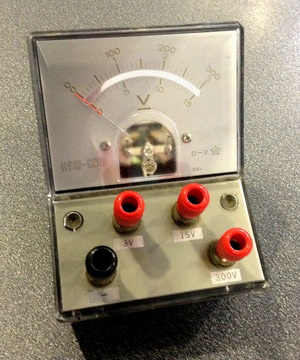
A picture showing an analogue voltmeter.
A voltmeter is a measuring device used to measure the potential difference between two points in a circuit.
About Voltmeters
- Voltmeters are added in parallel to components in a circuit to find the potential difference between two points.
- An ideal voltmeter has infinite resistance because otherwise adding an voltmeter to a circuit would change the Potential Difference between two points.
- Voltmeters can be analogue with a needle pointing to numbers on a dial or it can be digital with a number display.
| A voltmeter placed in parallel with a bulb. |
Key Stage 4
Meaning
A voltmeter is a measuring device used to measure the potential difference between two points in a circuit.
About Voltmeters
- Voltmeters are added in parallel to components in a circuit to find the potential difference between two points.
- An ideal voltmeter has infinite resistance because otherwise adding an voltmeter to a circuit would change the potential difference between the two points.
- Voltmeters can be analogue with a needle pointing to numbers on a dial or it can be digital with a number display.
| To measure the potential difference across bulb 1 the voltmeter must be placed in parallel with bulb 1. | To measure the potential difference across bulb 2 the voltmeter must be placed in parallel with bulb 2. |
| To measure the potential difference across bulb 1 the voltmeter must be placed in parallel with bulb 1. | To measure the potential difference across bulb 2 the voltmeter must be placed in parallel with bulb 2. |
| In this case both voltmeters will give the same measurement because the components themselves are in parallel. | |
References
AQA
- Voltmeter, pages 52-3, 56, GCSE Physics; Student Book, Collins, AQA
- Voltmeters, page 239, GCSE Combined Science; The Revision Guide, CGP, AQA
- Voltmeters, page 41, GCSE Physics, Hodder, AQA
- Voltmeters, page 52, GCSE Physics; Third Edition, Oxford University Press, AQA
- Voltmeters, pages 25, 106, GCSE Physics; The Revision Guide, CGP, AQA
- Voltmeters, pages 293, 296, GCSE Combined Science Trilogy 1, Hodder, AQA
- Voltmeters, pages 60, 61, 235, GCSE Combined Science Trilogy; Physics, CGP, AQA
- Voltmeters, pages 62, 63, 331, GCSE Physics; The Complete 9-1 Course for AQA, CGP, AQA
- Voltmeters; calibration of, page 316-17, GCSE Combined Science Trilogy 1, Hodder, AQA
- Voltmeters; calibration of, pages 64-5, GCSE Physics, Hodder, AQA
- Voltmeters; circuit symbol, page 38, GCSE Physics, Hodder, AQA
